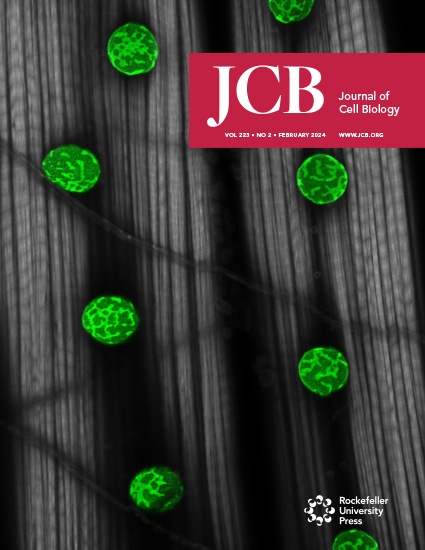Tension-induced suppression of allosteric conformational changes coordinates kinesin-1 stepping.
IF 7.4
1区 生物学
Q1 CELL BIOLOGY
引用次数: 0
Abstract
Kinesin-1 walks along microtubules by alternating ATP hydrolysis and movement of its two motor domains ("head"). The detached head preferentially binds to the forward tubulin-binding site after ATP binds to the microtubule-bound head, but the mechanism preventing premature microtubule binding while the partner head awaits ATP remains unknown. Here, we examined the role of the neck linker, the segment connecting two heads, in this mechanism. Structural analyses of the nucleotide-free head revealed a bulge just ahead of the neck linker's base, creating an asymmetric constraint on its mobility. While the neck linker can stretch freely backward, it must navigate around this bulge to extend forward. We hypothesized that increased neck linker tension suppresses premature binding of the tethered head, which was supported by molecular dynamics simulations and single-molecule fluorescence assays. These findings demonstrate a tension-dependent allosteric mechanism that coordinates the movement of two heads, where neck linker tension modulates the allosteric conformational changes rather than directly affecting the nucleotide state.张力诱导的变构构象变化抑制协调运动蛋白-1步进。
运动蛋白-1通过交替ATP水解和其两个运动结构域(“头部”)的运动沿着微管行走。在ATP与微管结合的头结合后,分离的头优先结合到前微管结合位点,但在伴侣头等待ATP时防止微管过早结合的机制尚不清楚。在这里,我们研究了颈部连接器(连接两个头部的部分)在这一机制中的作用。对无核苷酸头部的结构分析显示,颈部连接器基部的前方有一个凸起,这对其移动造成了不对称的限制。虽然颈环可以自由向后伸展,但它必须绕过这个凸起来向前伸展。我们假设颈部连接器张力的增加抑制了栓系头部的过早结合,这得到了分子动力学模拟和单分子荧光分析的支持。这些发现证明了一种张力依赖的变构机制,该机制协调了两个头部的运动,其中颈部接头张力调节了变构构象的变化,而不是直接影响核苷酸状态。
本文章由计算机程序翻译,如有差异,请以英文原文为准。
求助全文
约1分钟内获得全文
求助全文
来源期刊

Journal of Cell Biology
生物-细胞生物学
CiteScore
12.60
自引率
2.60%
发文量
213
审稿时长
1 months
期刊介绍:
The Journal of Cell Biology (JCB) is a comprehensive journal dedicated to publishing original discoveries across all realms of cell biology. We invite papers presenting novel cellular or molecular advancements in various domains of basic cell biology, along with applied cell biology research in diverse systems such as immunology, neurobiology, metabolism, virology, developmental biology, and plant biology. We enthusiastically welcome submissions showcasing significant findings of interest to cell biologists, irrespective of the experimental approach.
 求助内容:
求助内容: 应助结果提醒方式:
应助结果提醒方式:


